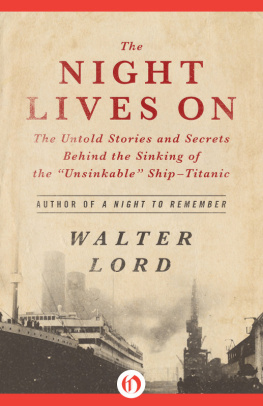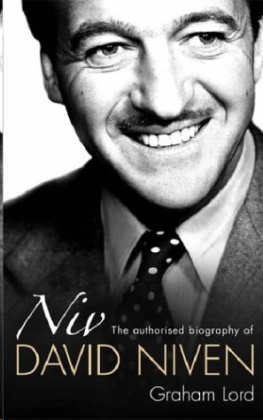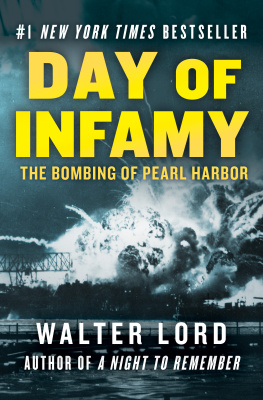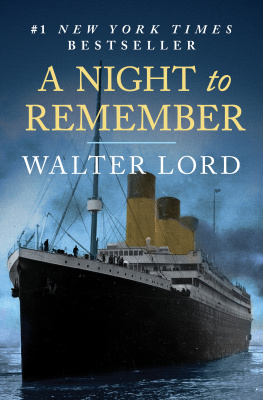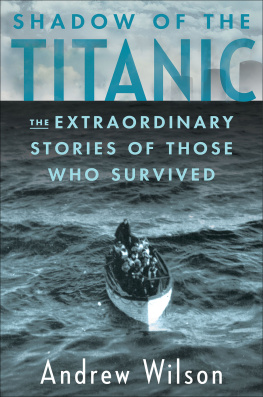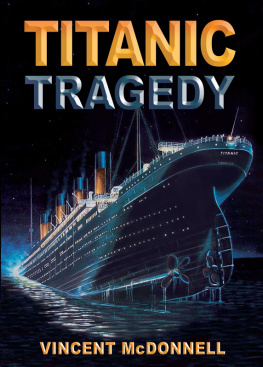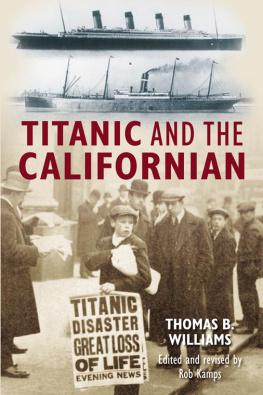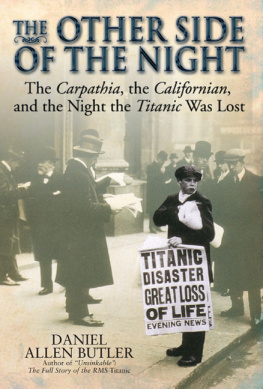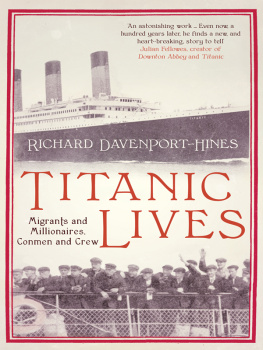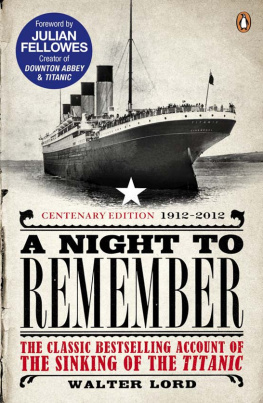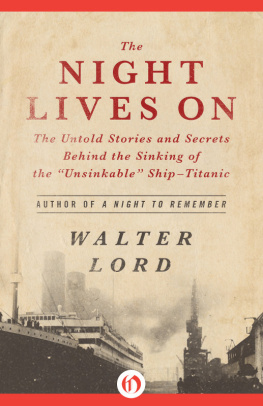
BUNDLE TITLE HERE
Walter Lord


A Night to Remember
Walter Lord

To My Mother
Foreword
IN 1898 A STRUGGLING author named Morgan Robertson concocted a novel about a fabulous Atlantic liner, far larger than any that had ever been built. Robertson loaded his ship with rich and complacent people and then wrecked it one cold April night on an iceberg. This somehow showed the futility of everything, and in fact, the book was called Futility when it appeared that year, published by the firm of M. F. Mansfield.
Fourteen years later a British shipping company named the White Star Line built a steamer remarkably like the one in Robertsons novel. The new liner was 66,000 tons displacement; Robertsons was 70,000. The real ship was 882.5 feet long; the fictional one was 800 feet. Both vessels were triple screw and could make 24-25 knots. Both could carry about 3,000 people, and both had enough lifeboats for only a fraction of this number. But, then, this didnt seem to matter because both were labeled unsinkable.
On April 10, 1912, the real ship left Southampton on her maiden voyage to New York. Her cargo included a priceless copy of the Rubiyt of Omar Khayym and a list of passengers collectively worth two hundred fifty million dollars. On her way over she too struck an iceberg and went down on a cold April night.
Robertson called his ship the Titan; the White Star Line called its ship the Titanic. This is the story of her last night.
Plan of Boat Deck of RMS Titanic

Time and place of events during the sinking of the Titanic
1) 11:40 P.M. - The bridge thanks the crows nest for reporting the iceberg.
2) 12:00 Midnight - Lawrence Beesley notices the deck has started to tilt.
3) 12:30 A.M. - John Jacob Astor slices open a life belt to show his wife whats inside.
4) 12:45 A.M. - The first rocket is fired.
5) 12:55 A.M. - Major Peuchen proves a yachtsman can be a seaman
6) 12:55 A.M. - Fifth Officer Lowe bawls out the head of the steamship line.
7) 1:10 A.M. - Mrs. Isidor Straus refuses to leave her husband.
8) 1:15 A.M. - If they are sending the boats away, they might just as well put some people in them.
9) 1:20 A.M. - Ben Guggenheim appears in evening clothes to go down like a gentleman.
10) 1:25 A.M. - Steward Ray remembers he persuaded a family to sail on the Titanic
11) 1:30 A.M. - Fifth Officer Lowe has to use his gun.
12) 1:35 A.M. - First Officer Murdoch prevents a rush on Boat 15.
13) 2:05 A.M. - Edith Evans gives up her chance in order to save a married woman with a family.
14) 2:10 A.M. - Wireless Operator Phillips life belt is almost stolen.
15) 2:15 A.M. - The band plays Autumn.
16) 2:18 A.M. - Colonel Gracie recalls a trick he learned at the seashore.
Plan of Bottom Deck of RMS Titanic

Time and place of events during the sinking of the Titanic
1) 11:40 P.M. - Engineer Hesketh and Fireman Barrett have to jump through the watertight door.
2) 11:40 P.M. - Iceberg tears 300-foot gash, ripping open first six watertight compartments.
3) 11:50 P.M. - Water is swirling round foot of spiral stairs.
4) 11:50 P.M. - Water pours in so fast that escaping air forces up hatch cover and hisses out of forepeak tanks.
5) 12:45 A.M. - Engineer Shepherd breaks his leg.
6) 12:45 A.M. - Electrician Alfred White brews some coffee.
7) 1:00 A.M. - Greaser Thomas Ranger turns off 45 fans.
8) 1:15A.M. - Stoker Fred Scott frees a trapped friend.
9) 1:20 A.M. - The sea pours in on Trimmer George Cavell.
CHAPTER 1
Another Belfast Trip
HIGH IN THE CROWS nest of the New White Star Liner Titanic, Lookout Frederick Fleet peered into a dazzling night. It was calm, clear and bitterly cold. There was no moon, but the cloudless sky blazed with stars. The Atlantic was like polished plate glass; people later said they had never seen it so smooth.
This was the fifth night of the Titanics maiden voyage to New York, and it was already clear that she was not only the largest but also the most glamorous ship in the world. Even the passengers dogs were glamorous. John Jacob Astor had along his Airedale Kitty. Henry Sleeper Harper, of the publishing family, had his prize Pekingese Sun Yat-sen. Robert W. Daniel, the Philadelphia banker, was bringing back a champion French bulldog just purchased in Britain. Clarence Moore of Washington also had been dog shopping, but the 50 pairs of English foxhounds he bought for the Loudoun Hunt werent making the trip.
That was all another world to Frederick Fleet. He was one of six lookouts carried by the Titanic, and the lookouts didnt worry about passenger problems. They were the eyes of the ship, and on this particular night Fleet had been warned to watch especially for icebergs.
So far, so good. On duty at 10 oclock a few words about the ice problem with Lookout Reginald Lee, who shared the same watch a few more words about the cold but mostly just silence, as the two men stared into the darkness.
Now the watch was almost over, and still there was nothing unusual. Just the night, the stars, the biting cold, the wind that whistled through the rigging as the Titanic raced across the calm, black sea at 22 knots. It was almost 11:40 P.M. on Sunday, the 14th of April, 1912.
Suddenly Fleet saw something directly ahead, even darker than the darkness. At first it was small (about the size, he thought, of two tables put together), but every second it grew larger and closer. Quickly Fleet banged the crows-nest bell three times, the warning of danger ahead. At the same time he lifted the phone and rang the bridge.
What did you see? asked a calm voice at the other end.
Iceberg right ahead, replied Fleet.
Thank you, acknowledged the voice with curiously detached courtesy. Nothing more was said.
For the next 37 seconds, Fleet and Lee stood quietly side by side, watching the ice draw nearer. Now they were almost on top of it, and still the ship didnt turn. The berg towered wet and glistening far above the forecastle deck, and both men braced themselves for a crash. Then, miraculously, the bow began to swing to port. At the last second the stem shot into the clear, and the ice glided swiftly by along the starboard side. It looked to Fleet like a very close shave.
At this moment Quartermaster George Thomas Rowe was standing watch on the after bridge. For him, too, it had been an uneventful nightjust the sea, the stars, the biting cold. As he paced the deck, he noticed what he and his mates called Whiskers round the Lighttiny splinters of ice in the air, fine as dust, that gave off myriads of bright colors whenever caught in the glow of the deck lights.
Next page
